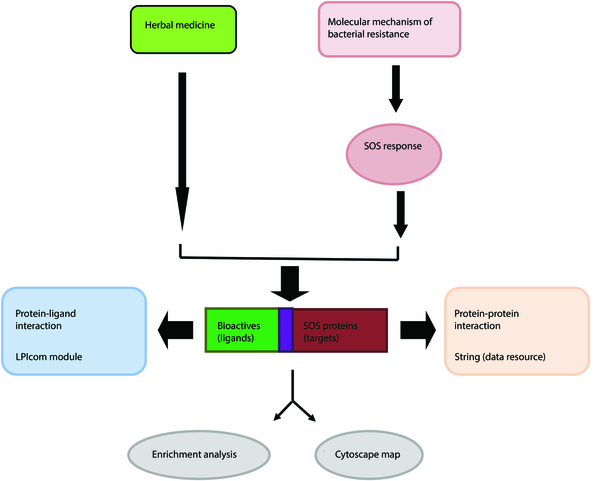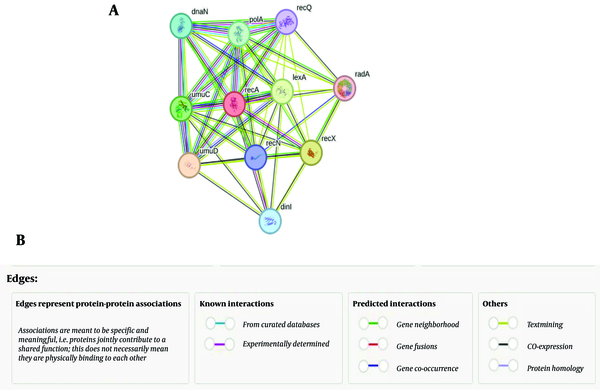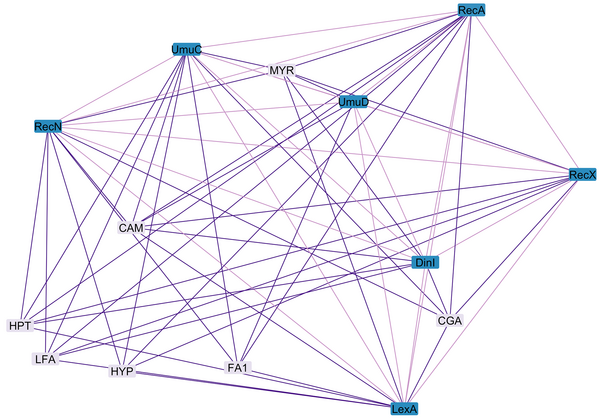1. Background
The SOS response is a vital adaptive mechanism bacteria employ to manage DNA damage and environmental stressors. It is particularly well-studied in Escherichia coli, where it plays a crucial role in maintaining genomic integrity. The SOS response is activated following DNA damage caused by environmental factors or chemical agents, such as antibiotics. The SOS network enables bacteria to assess the extent of the damage and initiate repair processes, thereby enhancing their chances of survival (1, 2).
RecA and LexA are vital SOS proteins. RecA binds to single-stranded DNA and forms a nucleoprotein filament that facilitates the repair of damaged DNA through homologous recombination. RecA activation promotes the autocleavage of LexA, a transcriptional repressor that inhibits the expression of various SOS genes. LexA cleavage leads to the de-repression of SOS genes, allowing the production of proteins involved in DNA repair, mutagenesis, and the regulation of RecA activity, such as RecN, UmuDC, DinI, and RecX (1, 3, 4). The coordinated action of these SOS proteins not only aids in repairing DNA but also increases the mutation rate, providing a survival advantage in fluctuating environments by promoting genetic diversity.
Under stress conditions, such as exposure to antibiotics like ciprofloxacin, the expression of SOS proteins is significantly heightened (5). Ciprofloxacin, a fluoroquinolone antibiotic, targets bacterial DNA gyrase and topoisomerase IV, leading to the accumulation of double-strand breaks in DNA. These breaks activate the SOS pathway, resulting in an upregulation of SOS proteins. Overexpression of SOS proteins facilitates DNA repair, contributes to the development of antibiotic resistance, and aids in the formation of persister cells. Persister cells can survive prolonged exposure to antibiotics (2-6). These cells pose a significant challenge in treating bacterial infections, as they can remain dormant and later repopulate once antibiotic treatment ceases.
In addition to understanding the SOS response and its implications for antibiotic resistance, there is growing interest in exploring alternative therapeutic approaches to combat E. coli infections. Herbal extracts have emerged as promising candidates due to their natural antibacterial properties. Several studies have demonstrated the efficacy of different plant-derived compounds in inhibiting the growth of E. coli (7). Herbal extracts often contain bioactive compounds with antimicrobial activity, making them potential adjuncts to conventional antibiotics. Different herbal formulations have shown effectiveness against E. coli, highlighting their role in enhancing food safety and public health.
As computational techniques evolve, disease networks developed through network biology provide valuable resources for pinpointing potential therapeutic targets. Hopkins' network pharmacology has enhanced clinical success rates and contributed to approximately 40% of new drug discoveries to date. This method is especially effective for investigating treatments for many diseases (8-11).
The intersection of SOS proteins under stress conditions and the potential of herbal extracts presents a multifaceted approach to addressing bacterial infections. Understanding how herbal elements interact can inform the development of new therapies. Strategies that utilize both natural compounds and the intrinsic mechanisms of bacterial survival, such as the SOS response, can facilitate the introduction of anti-SOS natural compounds. Therefore, it is crucial to implement these strategies to develop anti-SOS natural components aimed at eliminating ciprofloxacin-resistant E. coli. Figure 1 shows the flowchart of the present study.
2. Objectives
This article aims to explore anti-SOS bioactives, highlighting the intricate dynamics of bacterial resilience and presenting opportunities for innovative treatments to combat ciprofloxacin-resistant infections.
3. Methods
3.1. The Selection of Bioactives
Seven compounds were selected from the ligand list of the LPIcom module for this study based on their known antibacterial effects. These compounds include quinic acid (FA1), chlorogenic acid (CGA), hyperoside (HYP), heptacosane (HPT), eicosane (LFA), camphor (CAM), and myristic acid (MYR). The names and properties of the ligands are available in PubChem.
3.2. The SOS Response Targets for Bioactive
The SOS response is regulated by two key proteins, LexA (inhibitor) and RecA (activator). STRING (core data resource) was used to retrieve a functional RecA protein association network. The RecA network contains 11 proteins, including itself, LexA, DinI, PolA, UmuC, UmuD, RecX, DnaN, RecQ, RadA, and RecN (Figure 2). The first seven and the last proteins are classified as SOS proteins. The last three proteins are involved in recombination, while DnaN participates in DNA replication. SOS proteins were selected for analyzing protein-protein interactions (PPI) due to their overexpression following ciprofloxacin treatment (4). Proteins with weak interactions (P-value < 0.7) were excluded from the study. The LPIcom module was used to predict target-ligand interactions. Protein IDs and sequences were obtained from UniProt and NCBI. The Enrichr dataset was applied to predict proteins associated with SOS proteins.
3.3. A Network Construction
Cytoscape software version 3.10.2 was used to visualize, analyze, and edit the generated network. SOS proteins with strong interactions (P-value ≥ 0.7) were paired with each other, and SOS proteins (as targets) were paired with phytochemicals (as ligands) in an Excel file. After transferring the data pairs into Cytoscape, a network map displaying the SOS proteins (targets) and phytocomponents (ligands) was created.
4. Results
The Cytoscape network map is displayed in Figure 3. A total of 84 bioactive-target interactions were identified. The ligands with the highest number of interactions were CAM and MYR, while the ligand with the fewest interactions was LFA. Table 1 provides the PCID and the number of interactions each ligand has with the targets. Table 2 lists the protein IDs and the number of interactions with the ligands. Additionally, proteins more likely associated with SOS proteins are highlighted in Table 2. Proteins such as RPLF, TRXA, RPLB, and NADE were less likely associated with SOS proteins (P-value > 0.05, data not shown). The targets with the highest number of interactions were RecA, LexA, UmuC, and RecN, whereas UmuD had the fewest interactions (Table 3).
| Bioactive | PCID | Number of Interaction with Targets |
|---|---|---|
| FA1 | 6508 | 5 |
| CGA | 1794427 | 6 |
| HYP | 5281643 | 5 |
| HPT | 11636 | 6 |
| LFA | 8222 | 6 |
| CAM | 2537 | 7 |
| MYR | 11005 | 7 |
Bioactive Data
| SOS Protein | ID | Number of Interaction with Ligands | Protein Associated with SOS Proteins | Function | P-Value |
|---|---|---|---|---|---|
| RecA | P0A7G6 | 7 | CLPP | Caseinolytic mitochondrial matrix peptidase proteolytic subunit (human) | 0.045 |
| LexA | P0A7C2 | 7 | RPSE | 30S ribosomal protein S5 | 0.0019 |
| RecX | P33596 | 6 | - | - | - |
| DinI | P0ABR1 | 5 | - | - | - |
| UmuC | P04152 | 7 | - | - | - |
| UmuD | P0AG11 | 3 | RPSE | 30S ribosomal protein S5 | 0.0019 |
| RecN | P05824 | 7 | HGS | Hepatocyte growth factor-regulated tyrosine kinase substrate (human) | 0.041 |
Target Data
| Protein | Number of Amino Acid with Maximum Affinity-Number of Region with High Probability of Interaction | ||||||
|---|---|---|---|---|---|---|---|
| FA1 | CGA | HYP | HPT | LFA | CAM | MYR | |
| RecA | 2 - 0 | 7 - 0 | 8 - 0 | 2 - 0 | 2 - 0 | 40 - 5 | 75 - 12 |
| LexA | 3 - 0 | 9 - 0 | 6 - 0 | 1 - 0 | 1 - 0 | 20 - 3 | 40 - 10 |
| DinI | - | 2 - 0 | - | 2 - 0 | 2 - 0 | 1 - 0 | 1 - 0 |
| RecX | - | 15 - 0 | 3 - 0 | 2 - 0 | 1 - 0 | 9 - 1 | 37 - 5 |
| UmuC | 5 - 0 | 36 - 1 | 9 - 0 | 4 - 0 | 2 - 0 | 54 - 8 | 120 - 21 |
| UmuD | 2 - 0 | - | - | - | - | 16 - 4 | 21 - 4 |
| RecN | 22 - 4 | 29 - 2 | 12 - 0 | 2 - 0 | 2 - 0 | 74 - 11 | 147 - 28 |
Protein-Ligand Interaction
5. Discussion
Infectious diseases present significant public health challenges in many countries, primarily due to the rise of drug-resistant strains. The emergence of drug-resistant strains underscores the urgent need for new and effective treatments. Computational drug design offers a cost-effective and time-efficient alternative to traditional drug discovery methods, which are often expensive and time-consuming. This approach has become a powerful strategy for discovering and developing novel drugs from existing compounds (9).
Network pharmacology is grounded in the principles of receptor theory and biological network technology. It examines the synergistic interactions among multiple components, targets, and pathways related to drugs and diseases, providing insights into drug actions. Herbal medicine functions systematically and holistically, and network pharmacology enables herbal medicine research to go beyond the study of individual ingredients, targets, and diseases. This approach facilitates a more comprehensive exploration of the efficacy of medicinal plants and their underlying mechanisms of action (10). By using multiple levels of analysis, including omics datasets and in silico simulations, network pharmacology effectively analyzes the mechanisms underlying drug effects. Thus, network pharmacology is an ideal approach for addressing the complexities of traditional herbal medicine research (11).
In this study, the network pharmacology method was employed for the first time to predict the effective herbal components and potential targets of the SOS pathway and SOS proteins involved in the treatment of ciprofloxacin-resistant E. coli mutants. This study also aimed to present new adjuvants targeting SOS proteins.
Ciprofloxacin is commonly used to treat infections caused by E. coli. However, the emergence of ciprofloxacin resistance has necessitated new strategies to combat this issue, including the development of antibiotic adjuvants targeting efflux pumps and the SOS response pathway. Although several reports have identified AddAB/RecBCD synthetic inhibitor candidates, their development has been hindered by mammalian cytotoxicity and lack of in vivo efficacy (2). Herbal bioactive components, known for their antibacterial activity, offer an alternative approach. To mitigate the cytotoxic effects of synthetic inhibitors, constructing a network interaction between phytocomponents (ligands) and SOS proteins (targets) can facilitate the introduction of antibiotic adjuvants capable of impairing the entire SOS network.
This study revealed that MYR and CAM interact with seven SOS proteins involved in SOS regulation, SOS mutagenesis, and DNA repair. Notably, RecA, LexA, RecN, and UmuC interacted with all the bioactives analyzed in this study. Inhibiting RecA and UmuC proteins could prevent SOS induction and mutagenesis (2). Furthermore, inactivating RecN could halt RecA activities (3). Additionally, it was found that RecA and UmuD are possibly associated with human CLPP and HGS proteins, respectively (P-value < 0.05).
Camphor is a terpenoid derived from the bark of the Cinnamomum camphora tree and demonstrates strong antibacterial properties against various bacteria, including Streptococcus mutans, Enterococcus faecalis, Staphylococcus aureus, and E. coli (12). Myristic acid, a fatty acid obtained from Myristica fragrans, also exhibits significant antibacterial activity against Listeriamonocytogenes and S. aureus, as well as anti-cancer effects against various cancerous cells (13, 14).
The structure of the RecA protein includes a large central domain with two putative DNA-binding loops, L1 and L2, and two ATP-binding motifs, Walker A and B (15). Additionally, LexA's self-cleavage activity is entirely dependent on its C-terminal domain (CTD), particularly its cleavable loop (16). The present findings revealed that CAM and MYR could bind to SOS proteins, specifically to RecA's central domain and LexA's CTD. This suggests that the antibacterial activity of these compounds may be related to their anti-SOS activity; however, this hypothesis requires experimental validation.
5.1. Conclusions
The SOS response is a critical pathway in bacterial cells for addressing stress conditions, such as those induced by ciprofloxacin treatment. This study represents the first in-silico exploration to retrieve the functional RecA protein association network, identify SOS proteins with strong interactions among themselves and with herbal components, and pinpoint phytoconstituents with significant interactions with SOS network proteins. The findings propose CAM and MYR as promising candidates for further research to develop anti-SOS inhibitors aimed at enhancing ciprofloxacin efficacy.
It is recommended to conduct similar investigations with other herbal bioactives to identify additional adjuvants that could further improve the effectiveness of ciprofloxacin against E. coli infections.


